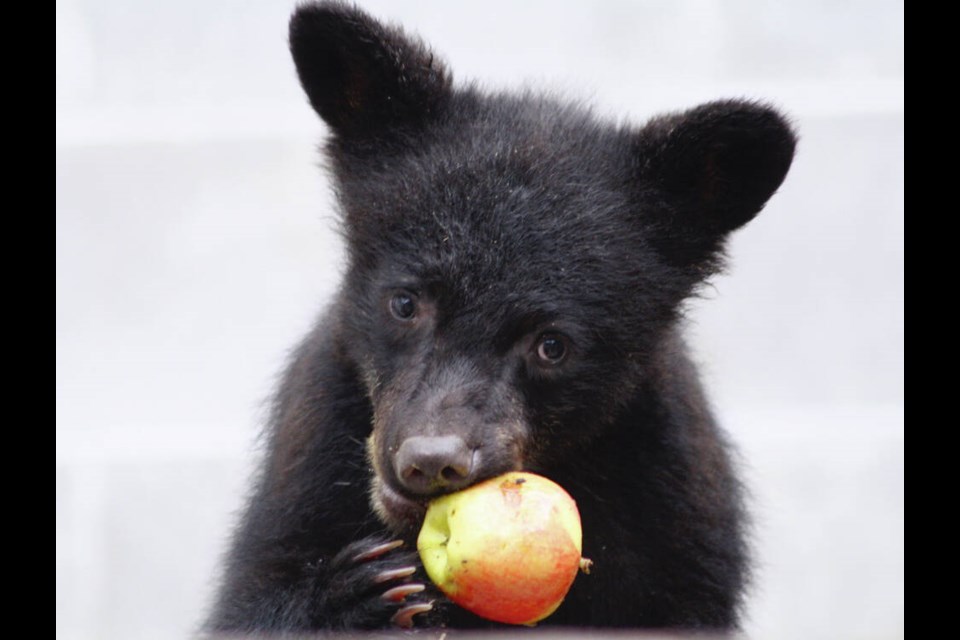Wildfires like the Cameron Bluffs blaze will send bears into new territories — and potential trouble — and cause massive disruptions in breeding patterns for other mammals and birds, say wildlife experts.
The fire is burning in steep terrain between Port Alberni and Coombs.
Derek Downes, who rehabilitates birds and bears at the North Island Wildlife Recovery Centre in nearby Errington, said it’s the time of year when black bears are out with their cubs trying to gain calories after hibernation, and fires are forcing them to flee to find new ranges and food sources.
He said that could push the animals closer to humans, where bears might get a taste for garbage, fruit trees and pet food.
“The Cameron Lake fire is 250 hectares … that’s a lot of area lost for the black bear,” said Downes.
The fires are hitting at a time when five orphaned black bear cubs taken in by the North island Wildlife Recovery Centre last year are being tagged and collared for release by the Environment Ministry.
While the centre hasn’t had any rescues yet this year, it’s expecting a spike, said Downes. “I think people should be really bear aware right now and start thinking about securing their garbage, because a lot of the cubs that come to us are because their mothers get into some sort of trouble or are killed.”
The five bear cubs set to be released include Campbell, a tiny cub found hiding behind a house plant in a Campbell River home last June. The little black bear cub, four months old and about 12 pounds, wandered through an open door after being separated from her mother, who was nowhere to be found.
The other four include Sookie, found under a deck near Sooke, also separated from its mother, and the Qualicum Triplets, who were orphaned about a month later.
All five of the bear cubs — three females and two males — are rambunctious and healthy, says the centre, which has raised and released more than 200 young bears since the program began in 1997.
As fires rage across the province, Downes said he expects to see increasing numbers of injured, sick or orphaned birds and bears. “Birds will have respiratory issues because of all the smoke, whether acute or chronic, and all types of animals and birds may have to adjust to new territories.”
He said amid that competition for food sources and range, “some will struggle,” as will smaller animals like squirrels and some insects.
Spring fires can affect several species, said Karen Hodges, a biology professor at the University of British Columbia’s Okanagan campus.
“If the tree with a nest burns, those eggs or chicks obviously will not survive. The adults might be able to escape the fire, but the chances that they would reproduce again somewhere else is unlikely for this year,” said Hodges.
Hodges said animals that can move away ahead of the fire will do so, but it depends on how fast the fire is moving.
With months of hot weather ahead, she fears things will only get worse. “I do expect a lot of animals to be displaced or killed,” she said. “I do expect some populations in some regions to be gone, or [be] small, for decades to come as a result of this year’s burns.”
Matthew Mitchell, research associate at the University of British Columbia’s land and food systems, said the carbon monoxide and particulate matter in wildfire smoke can have acute health effects on animals, some of which may not be seen for years.
“It can affect their lungs, it can change blood chemistry, lower oxygen levels, and so then you can also have effects on the immune system,” he said. “Those sorts of things can lead to changes in the demography, or the survival, growth and reproduction of animals as well.”
Wildfire smoke could also lead to changes in behaviour, including how active animals are, whether they look for mates and how much they sing, he said.
Scientists have observed fetuses of martens, a weasel-like mammal with a bushy tail, are negatively affected by wildfire smoke, Mitchell said. Early spring fires could affect pregnant animals or their newborns, just like they affect humans, he said.
A study published in February in the journal Ecology Letters examined the regenerative power of forest fires and found some ecosystems see “species richness” after a fire.
“How ecological and evolutionary drivers translate to effects on animal richness remains to be seen, but our findings show the cumulative effects to be strikingly positive, at least for bird and mammal richness,” the paper by Canadian, American and European researchers said.
Animals that have the ability to reproduce faster do better in a fire-prone environment, it noted.
But it warned that fires in areas where they are not a regular occurrence are not particularly beneficial. “In these ecosystems, fire is more of a modern threat than an important process to maintain, and recent fire activity in these systems is not a likely driver of richness,” it said.
— With files from The Canadian Press
>>> To comment on this article, write a letter to the editor: [email protected]



